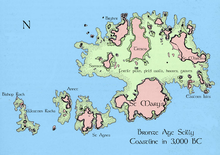Lyonesse
The exact nature of the crime is never specified, but the legend tells of a horrific storm that occurred over the course of a single night, resulting in an enormous wave that swallowed the kingdom.
Included among these legends are tales of local fishermen who claim that on calm days, one can still hear the bells of the many churches softly ringing in the seas off the west Cornish coast.
Continental writers of Arthurian romances were often puzzled by the internal geography of Great Britain;[dubious – discuss] thus it is that the author of the French Prose Tristan appears to place Léonois beside Cornwall.
In English adaptations of the French tales, Léonois, now "Lyonesse", becomes a kingdom wholly distinct from Lothian, and closely associated with the Cornish region, though its exact geographical location remained unspecified.
[1] One passage in particular references legends of Lyonesse and its rise from (and subsequent return to) the ocean: Then rose the King and moved his host by night And ever pushed Sir Mordred, league by league, Back to the sunset bound of Lyonesse— A land of old upheaven from the abyss By fire, to sink into the abyss again; Where fragments of forgotten peoples dwelt, And the long mountains ended in a coast Of ever-shifting sand, and far away The phantom circle of a moaning sea.
A Breton parallel is found in the tale of the Cité d'Ys or Ker Ys, similarly drowned as a result of its debauchery, with a single virtuous survivor, King Gradlon, escaping on a horse.
According to Welsh legend, the kingdom of Cantre'r Gwaelod in Cardigan Bay was drowned due to the drunkard negligence of its prince, Seithenyn, who allowed the sea to sweep through the floodgates.
The tale of Lyonesse is sometimes suggested to represent an extraordinary survival of folk memory of the flooding of the Isles of Scilly and Mount's Bay near Penzance[7] when the sea levels rose during the Bronze Age.
Cornish people around Penzance still get occasional glimpses at extreme low water of a sunken forest in Mount's Bay, where petrified tree stumps become visible adjacent to the Celtic Sea.

